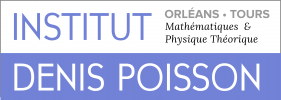Séminaire de Physique Théorique
The fully non-perturbative interaction regime in strong-field QEDArseny Mironov (Laboratoire pour l'utilisation des lasers intenses, Sorbonne Université, Paris)
Thursday 04 April 2024 14:00 - Salle des séminaires - Salle 1180, bâtiment E2
Résumé :
The Furry picture in QED is a powerful tool allowing to build the perturbative scattering theory in a strong external electromagnetic field that is accounted for exactly. Under the so-called locally constant field approximation for processes involving relativistic particles in transverse fields, the model of a uniform constant crossed field (CCF) appears to be universal, and at the same time allows analytical treatment for many processes. In it, the process probability rates can be characterised by the quantum dynamical parameter $\chi$, which denotes the field strength experienced by a particle in its reference frame in the units if the Sauter-Schwinger field $E_S=m^2c^3/e\hbar$ (here, $m$ and $-e$ are the electron mass and charge).
The first calculations by Ritus and Narozhny for the loop contributions to scattering amplitudes in a CCF have shown that at $\chi >> 1$ such corrections grow surprisingly fast, namely, as $g = \alpha\chi^{2/3}$ [1,2]. Narozhny conjectured that $g^n$ factors the leading-type n-th loop contributions in the perturbation expansion, meaning that at $g>1$ the Furry expansion breaks down and renders the new fully non-perturbative regime of strong-field QED. In one of our recent works [3], we substantiated this conjecture to all orders.
In this talk, following our works [3,4], I will review the Ritus-Narohny conjecture and discuss the resummation techniques for consistent treatment of scattering processes in the non-perturbative regime. I will also mention some implications for scattering amplitude calculations. The resummation is achieved for the leading-type Feynman diagrams, in which photon lines are replaced by the bubble chains of polarisation operators. In effect, such dressed photons obtain a dynamical mass depending on the quantum parameter $\chi$ and become unstable. This makes the formulation of scattering processes (e.g. emission of a photon by an electron) quite intricate. On the other hand, in the subcritical regime $g<1$, dressing can lead to trackable modification of the spin dynamics [5].
[1] V. I. Ritus, Radiative corrections in quantum electrodynamics with intense field and their analytical properties, Annals of Physics 69, 555 (1972).
[2] N. B. Narozhny, Expansion parameter of perturbation theory in intense-field quantum electrodynamics, Physical Review D 21, 1176 (1980).
[3] A. A. Mironov, S. Meuren, and A. M. Fedotov, Resummation of QED radiative corrections in a strong constant crossed field, Physical Review D 102, 053005 (2020).
[4] A. A. Mironov and A. M. Fedotov, Structure of radiative corrections in a strong constant crossed field, Physical Review D 105, 033005 (2022).
[5] I. Y. Kostyukov, E. N. Nerush, A. A. Mironov, A. M. Fedotov, Short-term evolution of electron wave packets in constant crossed electromagnetic fields with radiative corrections, Physical Review D 108, 093007 (2023).
Liens :
